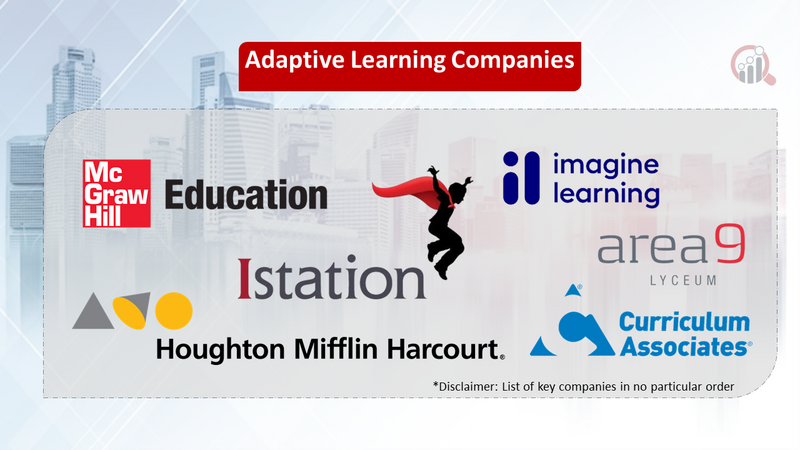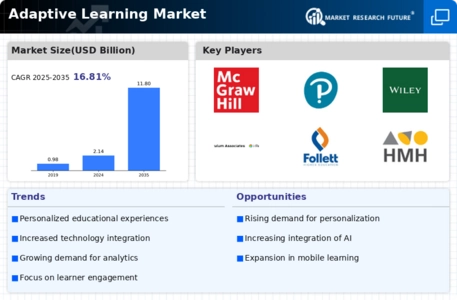Top Industry Leaders in the Adaptive Learning Market

Competitive Landscape of the Adaptive Learning Market: Navigating a Dynamic Terrain
The adaptive learning market is experiencing explosive growth, driven by rising demand for personalized learning experiences and the increasing adoption of technology in education. This dynamic landscape is home to a diverse range of players, each vying for a slice of the market pie. Let's delve into the competitive landscape, examining key players, strategies, market share analysis factors, emerging companies, and current investment trends.
Key Players:
-
McGraw-Hill (US)
-
Pearson (UK)
-
Curriculum Associates (UK)
-
Wiley (US)
-
Istation (US)
-
Area9 Lyceum (US)
-
ScootPad (US)
-
CogBooks (UK)
-
VitalSource (US)
-
DreamBox (US)
-
Impelsys (US)
-
Mathspace (Australia)
-
Fulcrum Labs (US)
-
Knowre (US)
-
Follett (US)
-
Imagine Learning (US)
-
Cerego (US)
-
Realizeit (US)
-
K12 (US)
-
Houghton Mifflin Harcourt (US)
Strategies Adopted:
-
Content Specialization: Players are focusing on developing adaptive content tailored to specific subject areas, learning styles, and student demographics.
-
Data-Driven Personalization: Advanced algorithms analyze student data to personalize learning paths, recommend relevant content, and adjust difficulty levels in real-time.
-
Integration with Existing Systems: Players are creating platforms that seamlessly integrate with existing learning management systems (LMS) and other educational software.
-
Partnerships and Acquisitions: Strategic partnerships and acquisitions are common, allowing companies to expand their reach, acquire new technologies, and access new markets.
Factors for Market Share Analysis:
-
Breadth and Depth of Content: The range and quality of adaptive content offered significantly impact market share.
-
Technology and Innovation: Continuous development of advanced algorithms, AI integration, and user-friendly interfaces is crucial for success.
-
Scalability and Affordability: Platforms should be scalable to accommodate large user bases and offer flexible pricing models to attract diverse customers.
-
Global Reach and Localization: Adapting platforms and content to different languages and cultural contexts opens up new markets.
New and Emerging Companies:
-
Guild Education: Offers personalized career training programs through adaptive learning technology.
-
General Assembly: Provides data-driven online courses and bootcamps with adaptive learning elements.
-
OpenClassrooms: Focuses on project-based learning with adaptive pathways and personalized feedback.
-
Duolingo ABC: Combines adaptive learning with gamification to make language learning engaging for children.
Current Company Investment Trends:
-
Focus on AI and Machine Learning: Companies are investing heavily in AI-powered algorithms to personalize learning experiences and optimize content delivery.
-
Expansion into New Markets: Players are entering new geographical markets and adapting their offerings to cater to diverse educational needs.
-
Content Acquisition and Development: Investing in high-quality, adaptive content creation and acquisition is crucial for differentiation and market share growth.
-
Partnerships and Ecosystem Building: Collaboration with educational institutions, technology providers, and content creators is key to building a robust ecosystem.
The Future of the Adaptive Learning Market:
The adaptive learning market is expected to continue its rapid growth, driven by increasing demand for personalized learning, technological advancements, and government initiatives. This dynamic landscape will see established players solidifying their positions, innovative startups emerging, and technology giants entering the fray. Understanding the competitive landscape, key players, and current trends will be crucial for success in this exciting and transformative market.
Latest Company Updates:
-
Dec 12, 2023: McGraw-Hill Education partners with Cognitize to offer adaptive learning solutions for K-12 math education.
-
Dec 15, 2023: DreamBox Learning acquires Thinkster Math, creating a leading provider of adaptive math learning for K-12.
-
Jan 8, 2024: A study by the University of Pennsylvania finds that adaptive learning software can significantly improve student learning outcomes in science.

